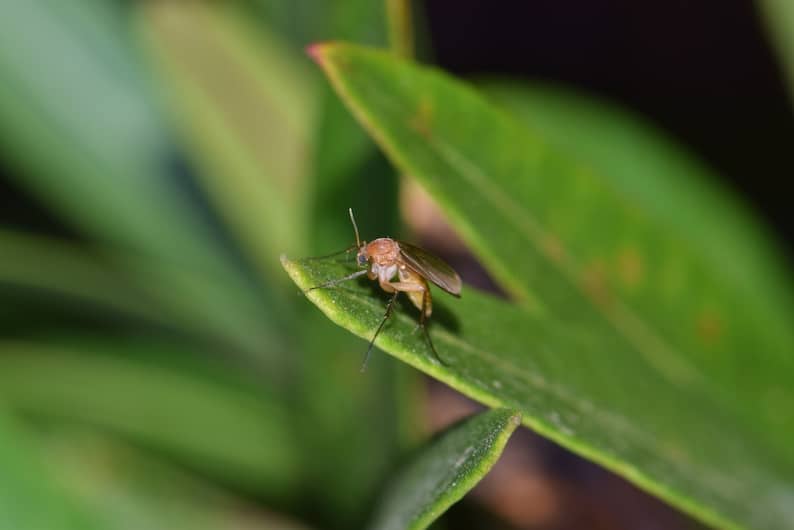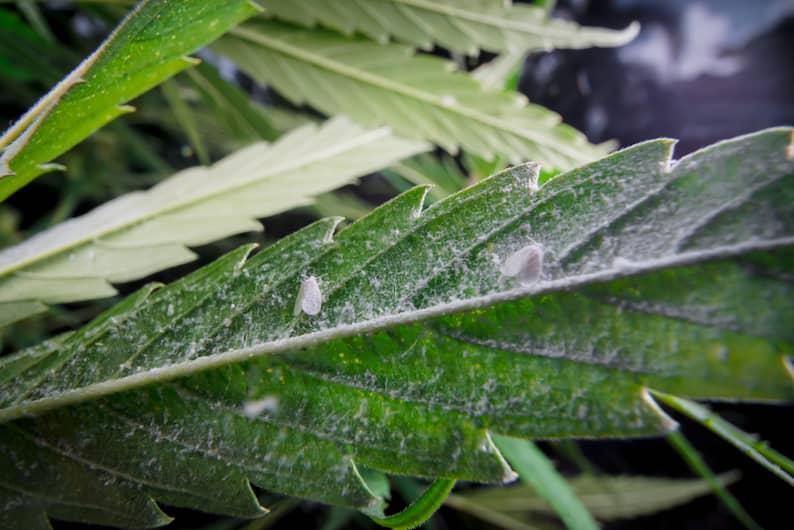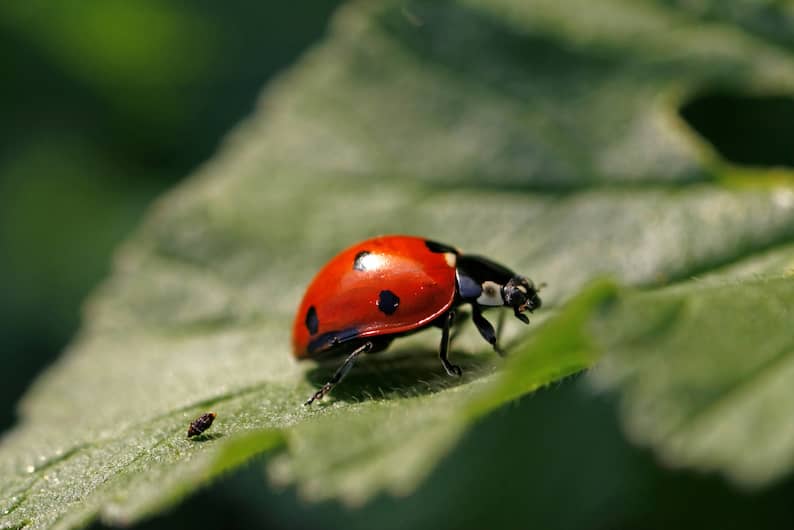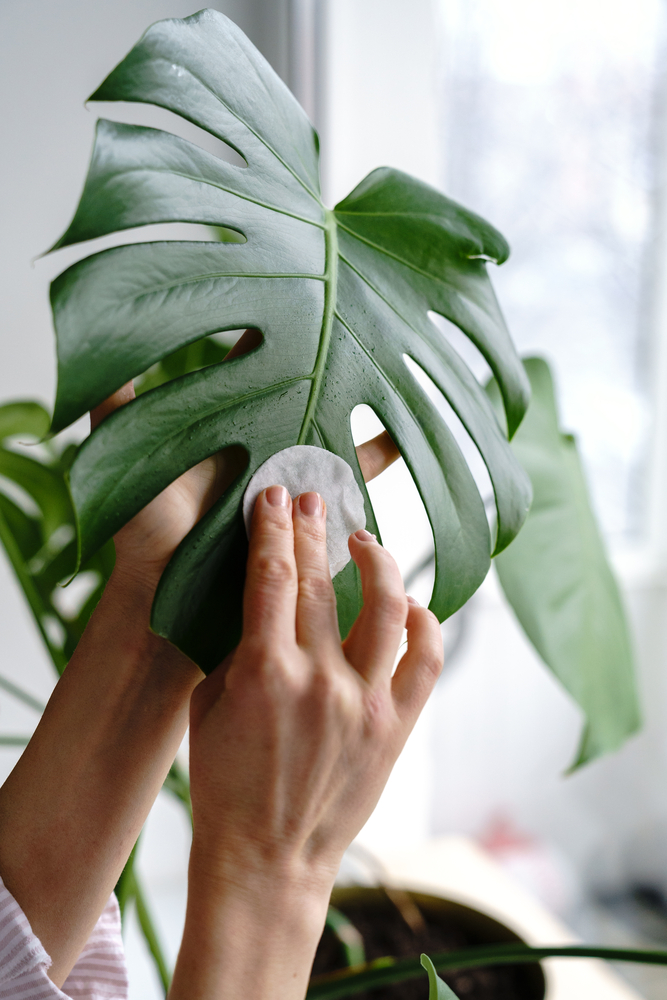If you’re one of the lucky people who have a Monstera deliciosa in your home, then you know what a beautiful and interesting plant it is. But like all plants, Monsteras can be susceptible to pests and diseases.
While this isn’t ideal, it’s also very likely to be entirely manageable. I’ll show you some of the most common pests on Monstera that you’ll find as well as the more likely Monstera diseases that may affect your plant.
Importantly, you’ll see just how to treat them along with some tips on how to prevent these problems from occurring in the first place.

Table of Contents
Most common Monstera pests and diseases
The best way to deal with pests and diseases is to learn how to prevent them in the first place. But sometimes, even the most diligent gardener can end up with a plant that’s not looking its best.
Here are some of the most common problems that can affect Monsteras:
1. Spider mites
Spider mites will drain your Monstera plant of its chlorophyll. As this green-colored substance is removed from the leaf, small white spots or stipples will be visible. Over time, the leaves will turn yellow and then brown as the mites continue to feed.
Quick tip: Although spider mites appear as tiny moving dots to the naked eye, their webs are much easier to see. Look for these web fibers to confirm that the pest is actually a spider mite.
2. Aphids
The older Monstera leaves are too tough for the aphids’ teeth to penetrate, so they feed on the new growth. Depending on the species, they can be white, green, white, yellow, red, brown, or black.
Their primary diet is sap and they produce large quantities of a waste product called honeydew. Consequently, leaves become infested with sooty mold.
Interestingly, one of the best things you can use to deal with an aphid infestation (and thrips, which I’ll get to below) are ladybugs! This is also an eco-friendly method that poses no risk to your plant. You can actually buy ladybugs for this exact purpose at that link – and it’s completely cruelty-free.

3. Scale
This is one of the more common pests on Monstera that you may run into. These armored insects come in many different colors but are usually a beige or brown hue. They are very small and can be found on the leaf and stem of your plant.
Brown scale on Monstera aren’t very active pests and prefer to stay in place while feeding on the plant’s sap. This may make you mistake them for an infection or fungus. However, if you look closely, you will see that they have small legs and are actually moving very slowly.
4. Leafminers
A leafminer isn’t a single bug. It’s actually a group of several pests that burrow into Monstera plant leaves to eat and feed on their surface. You should usually find it pretty easy to identify the light yellow trails or splotches that they leave behind.
Moth larvae are one of the most common Monstera pests. These small, winged insects lay their eggs on the surface of Monstera leaves. When the larvae hatch, they immediately start mining through the leaf, leaving a telltale trail behind them.
5. Fungus gnats
If you see small, dark-colored bugs flying around your plant, chances are they’re fungus gnats.
These tiny fungus gnats typically lay their eggs in potting soil and other types of potting medium where plants are grown. Their main diet is organic matter in the soil, but they can also eat plant roots, damaging and weakening the plant.

6. Whiteflies
Whiteflies are small, white insects that fly around plants and feed on their sap. They can reproduce very quickly and lay hundreds of eggs at a time.
Whiteflies are particularly damaging pests for Monstera plants because they can transmit viruses from one plant to another. As they feed, they defecate on the plant, which attracts other pests and can cause fungal growth.
7. Mealy bugs
Usually white and oval-shaped with a waxy coating, mealybugs are a common pest of plants indoors. You can find white clusters of eggs among your plant’s grooves and crevices.
Mealybugs eat the sap of plants, stunting growth and causing yellowing. Their presence can eventually lead to the death of plants.

8. Thrips
Thrips are small, light brown in color, and have tiny wings. Usually, they hang around the veins of leaves. They leave discolorations and are difficult to deal with.
You can identify a thrip by its rice-shaped tiny body. Thrips look like little dark slivers on your Monstera plant.
Unless you have a magnifying glass, it’s hard to see their bodies clearly, but up close, they resemble lobsters. You can see them better if you shake them against a white background such as a piece of paper.
Find out more: 6 Simple Tips to Get Rid of Thrips on a Monstera
9. Anthracnose
This is a type of fungal disease that affects Monstera leaves, causing them to discolor and eventually die. The fungus thrives in moist conditions and can be spread by water droplets.
It’s important to identify anthracnose early so you can take steps to control it. Otherwise, the fungus will continue to spread and cause serious damage to your plant.
10. Bacterial leaf spot
If you see dark brown leaves on your Monstera, it’s likely that they’re affected by bacterial leaf spot. This is a common disease of Monsteras and can be caused by several different bacteria.
The bacteria penetrate the leaves through natural openings or wounds and cause the tissue to break down. This results in brown spots on the leaves which can eventually lead to the death of the leaf.
Related: 10 Signs of Bacterial Leaf Spot on Monstera (and How to Treat It)
11. Stem and root rot
Stem and root rot is a serious disease that can kill your Monstera plant. Root rot on your Monstera is caused by a fungus or bacteria that attacks the plant’s roots, causing them to rot.
The first sign of stem and root rot is usually yellowing Monstera leaves. This is followed by wilting and eventually death.
12. Mosaic virus
Learning how to identify mosaic virus on your Monstera is critical as often the first symptom looks very similar to the pattern you’ll find on a variegated Monstera.
However, there is unfortunately no cure for this virus and it’s very contagious, so the quicker you spot it, the less chance there is of it jumping to another plant in your collection.
How do you get rid of pests on Monstera?
First, try to identify the type of pest that is causing the problem. This will help you choose the most effective treatment method, including manually removing pests and spraying the plant with neem oil, insecticidal soap or a pesticide. You can also use ladybugs to control certain infestations.
It can be a drag when your prized Monstera plant becomes infested with pests, with some of the most common Monstera pests and diseases including mealybugs, aphids, thrips, whiteflies, and scale insects. But don’t worry, there are a few things you can do to get rid of them.
Once you’ve identified the pest, there are a few different treatment options:
- Physical removal: This includes manually removing the pests from the plant with your hands or a cotton swab dipped in rubbing alcohol. For some Monstera pests, you should also try using a sticky trap to catch them. This sticky trap absolutely does the job you need it to do.
- Biological control: This involves using other organisms to kill the pests. For example, ladybugs eat aphids and can be used to control an infestation. You can buy ladybugs here to do just that as your very own eco-friendly, pest control army.
- Chemical control: This is the last resort option and should only be used if other methods have failed. Be sure to use a product that is specifically designed for the type of pest you’re dealing with.
Remember, it’s important to act quickly when you see pests on your Monstera plant. Remove the infested plant to an isolated space in your home. This will help to prevent the pests from spreading to other plants.

How to prevent pests and diseases on Monstera
The best way to deal with pests and diseases is to prevent them from happening in the first place. Here are a few tips for keeping your Monstera safe and happy:
- Avoid overwatering your plant. An overwatered Monstera can lead to stem and root rot, which is difficult to treat.
- Make sure your plant has good drainage. Water that sits in the pot can lead to fungal diseases like anthracnose.
- Keep your plant healthy by fertilizing it regularly and providing the proper amount of light. A healthy Monstera being fertilized with the nutrients it needs is less likely to get infected.
- Try not to damage the leaves of your plants. When there are wounds on the leaves, it’s easier for pests and diseases to get in.
- Regularly dust your plants. Certain pests look for dry undisturbed areas on your plant. To avoid this, clean your Monstera leaves to keep them shiny and pest-free.
What does a diseased Monstera look like?
Diseased Monstera plants can exhibit a variety of symptoms depending on the type of disease. Common symptoms include yellowing leaves, brown or black spots on leaves and wilting. You may also notice its growth is stunted compared to its usual growth rate or that new growth is leggy.
You’ll notice a spread of these symptoms if your plant is affected by a disease. If you catch the disease early, you may be able to save your plant and remove a few leaves that are affected. However, if it’s left untreated, the plant will eventually die.
A diseased Monstera can also look similar to a plant that is underwatered, overwatered, or sunburnt. It’s important to carefully observe your plant and look for other signs of disease such as fungal growth or pests.
Your diseased Monstera may also have stunted growth, and won’t grow as large as its healthier counterparts. If your Monstera has been sluggish when it comes to your Monstera growing new leaves, it may be because of an underlying disease issue.
Finally, Monstera plants become more leggy and sparse when they are diseased. This is due to the plant’s inability to produce new leaves, causing it to stretch out in an attempt to get more light. This may also lead to the leaves bending and drooping.
How do you identify pests on Monstera?
If your Monstera has a pest infestation, you may notice discoloration, bumps, streaks, or brown spots on the leaves of your plant. The moisture level of the plant itself may also shift, appearing dried out and crispy or overly soft and droopy.
If you see these symptoms, it’s important to take a closer look at your plant to confirm that it is infested with pests. Pests can be difficult to spot, but there are a few tell-tale signs that your plant is infested.

As mentioned above, spider mites create webs and certain bugs produce the waste product honeydew. So if you can’t see the bug itself, these byproducts will help you to identify an infestation.
To better see the pests on your Monstera plant, you may need to use a magnifying glass and a light. This can help you to identify the type of pest on your plant, so you can choose the most effective treatment method. You can also shake a leaf so that the pest falls onto a white or black background such as a table or piece of paper where it will be easier to see and identify.
If you’re not sure whether your plant has pests, you can take a sample of the affected leaves to a local nursery or garden center for identification. They will be able to tell you for sure and help you choose the best course of action.
